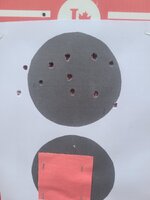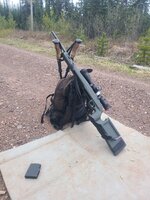ResearchinStuff
WKR
I make my kids color the circles in with crayons.
Follow along with the video below to see how to install our site as a web app on your home screen.
Note: This feature may not be available in some browsers.
Because rifles shoot to a cone. Because wobble zone shrinks as you get closer to the ground and add support. Because shooting at 100yd and extrapolating to distance is convenient.@Formidilosus
Apologies if it was answered elsewhere...
What's the significance of different size targets-the absolute size change of MOA at different distances?
Assuming the training is specific to hunting/killing big game, what's the disadvantage of shooting 1 conistent and conservative vitals size target (~8 or 10" plate) from every position and distance? Similar to the paper plate post earlier in the thread?
When you miss from x position and y distance you know your limits and what to work on (?)
Totally understand the convenience point but not following the logic on the first two points.Because rifles shoot to a cone. Because wobble zone shrinks as you get closer to the ground and add support. Because shooting at 100yd and extrapolating to distance is convenient.
-J
Yeah I don't think we're tracking.Totally understand the convenience point but not following the logic on the first two points.
If one can conveniently shoot out to 500, owns one or many 10" plates and whether by setting up plates at random distances from say 50 to 500 yards or by moving the shooter to different distances and shooting at a single plate, what advantage do the paper targets and moa guidelines hold, other than in the case of not having convenient of access to longer ranges?
The animals vitals aren't changing size according to distance, why add the variable complexity of moa?
If a person doesn't miss a 10" ~10 moa target at 100 yards from any positions but misses the 10" ~2 moa target at 500 from certain or all positions, that tells you everything you need to know and work on, no?
maybe I'm missing the point(?)
Got it, that makes sense now, ty. I certainly see the benefits of the drill to establish a baseline for the shooter+system at short range, without additional variables = windYeah I don't think we're tracking.
1) The target sizes are indicative of the wobble zone that should be achievable from each position, as measured in an angular unit - MOA or Mils for example. That is, 2 inches from the prone in this drill isn't 2 inches - it's 2 MOA.
2) Yes, animal vitals do not change size depending upon what distance they are from you. However, different shooting positions will enable different wobble zones which will restrict maximum effective range for that position.
Putting this together:
If you know you are an on-demand 2 MOA shooter/system from the prone, and you know that your animal vitals are 10 inches round, then you know that you should likely be effective from that position to 500 yards.
If you know you are an on-demand 4 MOA shooter/system from the kneeling supported, and you know that your animal vitals are 10 inches round, then you know that you should likely be effective from that position to 250 yards.
Is this making sense? Yes, you could replicate the spirit of this drill by taking 10 inch plates and placing them at a variety of distances, and shooting them from the positions that correspond to their scaled angular width at 100 yards. That would be fun, but you'd never know if your misses were truly due to fundamentals (and the extent of your wobble zone in a given position) or due to wind. It would also be substantially harder to track the improvement in your positional shooting (reduction in wobble zone) over time as you practice and repeat the drill.
-J
Convenience. Most people can't shoot out to 500 yards on a regular basis. Paper also shows WHERE you hit and miss, allowing you to diagnose your process. If you were super serious about improving, you could add scoring rings inside each target and track your progress. The targets are likely sized in MOA so hunters (I think most still use MOA) can work out how big of a vital zone the target would represent at various distances. Doing flat range work also makes the drill repeatable and directly comparable/standardized between everyone.If one can conveniently shoot out to 500, owns one or many 10" plates and whether by setting up plates at random distances from say 50 to 500 yards or by moving the shooter to different distances and shooting at a single plate, what advantage do the paper targets and moa guidelines hold, other than in the case of not having convenient of access to longer ranges?
Antelope and moose have different sized vitals. Building targets around an angular value (MOA) lets you represent whatever combination of target size/distance that is relevant to you for each target size. A 2 MOA target could represent a broad side moose at 1,150 yards (24" wide vitals) or a partial exposure on an antelope at 400 yards (8 inch wide vitals). The assessment doesn't take into account wind, bullet velocity, bullet construction etc, so I'm sure its not meant to give you a limit on how far you can kill a given animal. But it is standardized, repeatable and relevant to anyone who wants to do the math.The animals vitals aren't changing size according to distance, why add the variable complexity of moa?
Is that miss due to wind or technique? How far did they miss? How centered were the hits? This is why paper has value.If a person doesn't miss a 10" ~10 moa target at 100 yards from any positions but misses the 10" ~2 moa target at 500 from certain or all positions, that tells you everything you need to know and work on, no?
If one can conveniently shoot out to 500, owns one or many 10" plates and whether by setting up plates at random distances from say 50 to 500 yards or by moving the shooter to different distances and shooting at a single plate, what advantage do the paper targets and moa guidelines hold, other than in the case of not having convenient of access to longer ranges?
Got it, that makes sense now, ty. I certainly see the benefits of the drill to establish a baseline for the shooter+system at short range, without additional variables = wind
So if we can can, with confidence through the drill, say "I'm capable of 2 moa on demand from this position" then I can dial in my wind calls if I'm missing a 10 inch plate at 300 rather than questioning/messing around with the shooter+system.
Tracking. Thanks
@Formidilosus
Apologies if it was answered elsewhere...
What's the significance of different size targets-the absolute size change of MOA at different distances?
Assuming the training is specific to hunting/killing big game, what's the disadvantage of shooting 1 conistent and conservative vitals size target (~8 or 10" plate) from every position and distance? Similar to the paper plate post earlier in the thread?
When you miss from x position and y distance you know your limits and what to work on (?)
Convenience. Most people can't shoot out to 500 yards on a regular basis. Paper also shows WHERE you hit and miss, allowing you to diagnose your process. If you were super serious about improving, you could add scoring rings inside each target and track your progress. The targets are likely sized in MOA so hunters (I think most still use MOA) can work out how big of a vital zone the target would represent at various distances. Doing flat range work also makes the drill repeatable and directly comparable/standardized between everyone.
Antelope and moose have different sized vitals. Building targets around an angular value (MOA) lets you represent whatever combination of target size/distance that is relevant to you for each target size. A 2 MOA target could represent a broad side moose at 1,150 yards (24" wide vitals) or a partial exposure on an antelope at 400 yards (8 inch wide vitals). The assessment doesn't take into account wind, bullet velocity, bullet construction etc, so I'm sure its not meant to give you a limit on how far you can kill a given animal. But it is standardized, repeatable and relevant to anyone who wants to do the math.
Is that miss due to wind or technique? How far did they miss? How centered were the hits? This is why paper has value.
I think the point of this course of fire is to use it as a diagnostic, to show me where I am weak and where I'm weaker haha. It doesn't pretend to replace shooting at distance. When you shoot in the field and add wind, terrain and other factors you limit the number of dudes that can participate and remove the standardization/scoring metrics.
Again, steel doesn't give you the whole story. Freshly painted steel is helpful for seeing splash. And properly mounted steel can give you an idea of where you hit based on the targets reaction. Back in the day we spent time shooting paper at long ranges and having each hit marked (by a down range team member) and immediately shown to the shooter. This immediate feedback let the shooter (and spotter) know exactly where they hit or missed (if it was a near miss). I'm not some super shooter, I rarely shoot past 700 yards, I'm just giving some context on why there is value in shooting paper.
I think a big part of it is removing all variables other than your shooting. You presumably zero at 100 so no elevation dialing or drop calculation mistakes and no wind impact. This is purely a test of your proficiency on the shot. I think I recall reading about this drill (or hearing on the podcast) from form that once mastering this that you should move on to actual ranges where dialing and wind come into the picture. But fist get the fundamentals of the shot down and then add variables.
My take away was added peer pressure increases difficulty.

Ha! I made them, if you see one someone got it from likely here or possibly the campfire. Shoot2Hunt also has a printed version for sale, nice paper, added some color accents I believe.Saw these in the garbage at the range a while back. @Carl Ross - were these targets from somewhere else or did you create them?
Any roksliders shooting at the itasca range in Grand Rapids mn?View attachment 882542


Tikka superlite .243 8 twist, Swfa 10x42 milquad gen 2, sports match rings, 108 eldmNice, what gun
